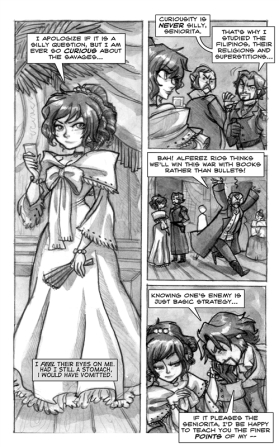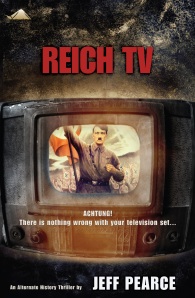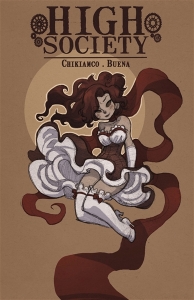Category Archives: Alternate History
Fistful of Reefer by David Mark Brown (2011)
 Smashwords / Amazon / Author’s Site
Smashwords / Amazon / Author’s Site
3/5 stars
Description:
In 1918, when Chancho Villarreal and his friends inadvertently create the legend of El Chupacabra, they draw the attention of Texas Ranger J.T. McCutchen to their goat ranch and marijuana farm north of Del Rio, Texas. What follows is an action-packed ride across the wilds of a Texas haunted by rumors of Chupacabras behind every bush.
This double-fisted, dieselpunk weird-Western resides between No Country for Old Men and The Three Amigos.
Review:
Fistful of Reefer has a killer premise. It’s a Weird West/dieselpunk adventure set in Texas about a gadgeteer genius Mexican marijuana farmer who’s on the run from a bordering-on-psychotic prohibitionist Ranger. It’s the first novel in the Reeferpunk series.
The opening scene sucked me in. Ranchers confront Chancho about their dead goats, and one reaches for his pistol and growls, “The goats didn’t die from demon curse or fright, they died from colic–from too much marihuana.” There are shootouts, chili-bombs, and epic chase scenes involving bales of marijuana. What more could one ask for?
The flippant prose is delightful in its old school pulp style, and the action sequences are thrilling. I’d probably re-read some of the fight scenes because they’re that awesome.
For a book that promotes itself as a dieselpunk adventure, there isn’t much dieselpunk machinery, although Chancho makes a pretty epic marijuana harvester that runs on manure. I hope Chancho displays more of his gadgeteer genius skills in the future.
I liked that the protagonists were a Mexican man, indigenous woman, and Black Seminole in a Weird West. But unfortunately, there’s a lot of forced sentiment regarding protagonists, but your mileage may vary. If you like the melodrama and romanticism found in old movies like María Candelaria, then it won’t bother you, but I found it to be dated and uncomfortably bridging on noble savage tropes with its cultural baggage (which requires taking its portrayals of indigeneity with a truckload of salt).
Characterization isn’t Fistful of Reefer‘s strong suit. Everyone can be summed up in two traits. They’re still charming in that pulp fiction way, but I wanted more depth in the protagonists. I still really like that they are the heroes in a Weird West, but I wish they were more often defined by their personality, with their background informing their point of view, rather than being almost nothing more than their background. The story should make it clear that Chancho is a loveable rogue because he’s Chancho, and not because he’s Mexican; Nena is a brave woman because she’s Nena, not because she’s of the Kickapoo people; and Muddy is loyal and dependable because he’s Muddy, not because he’s Black Semiole.
Pages of infodumping about the protagonists’ histories take away the story’s momentum. Along the same lines, there’s a lot of telling instead of showing with regards to their character traits. There’s a disconnect between what their traits are supposed to be, versus what they are actually doing in the story. I can’t say I’m impressed by the protagonists, but in contrast, the villain Ranger McCutchen is an excellent character. His motivations and history are revealed more naturally in smaller segments, and his actions speak for themselves. The narration didn’t have to tell me explicitly that he’s creepy and insane. He just is. This would be a much stronger book if the protagonists’ character traits were laid out in a similar manner.
Chancho’s aspirations grow larger towards the end of the book, instead of merely trying to outrun the ranger, he starts having loftier dreams of liberating the American people. Unfortunately, I was confused as to what this exactly meant. Does liberating the people mean liberating them from prohibition? Is it strictly about marijuana or is it more than that? Even though it’s not clear what Chancho stands for, people turn up in droves to support him, because the narration claims that he’s a Good Guy and stands for Good Things. So at the end of the book, I was left confused and unfulfilled.
Even though I have a number of criticisms with Fistful of Reefer, I commend the author for creating a fun and unique world, and I think that the series has promise.
You might like this if you like…
Weird West; race and chase scenes; liberation from prohibition; pulp fiction; sweet ganja
The sequel, The Austin Job, is now available on Amazon.
David Mark Brown has some free serialized novellas set in the same world. You can read them on his website under “Reeferpunk“.
High Society by Paolo Chikiamco and Hannah Buena (2011)
4/5 stars
Description:
Take your first step into a world of automata, magic, and alternative history! The year is 1764, and, for the first time in nearly two centuries, the Spanish forces have been repelled from the great walled city of Manila. While the Spaniards are quick to lay the blame at the feet of the invading British and their clockwork machines, the secret to the success of the Filipinos may lie closer to home, with an ally that is both ancient and new, mythical and mechanical. “High Society” is a stand-alone steampunk comic book in the “Wooden War” series.
Review:
High Society is an excellent start to a steampunk comic series set in Spanish colonial era Philippines, an alternate history take on the struggle for independence. The issue is in black and white and only 24 pages long, but it’s packed with adventure, creative world-building, and an inspiring spirit.
Chikiamco’s 18th century setting weaves together steampunk and Filipino mythology in an innovative way, but it’s not done for novelty—they’re part of the post-colonial themes that the series promises to explore. It’s not post-colonial merely in the strict historical sense (in the fight against Spain), but it’s also about reclaiming a people’s humanity and self-determination.
Did you know, that before the Spanish arrived, we had a goddess of lost things? I wonder if everything we’ve ever lost is still out there somewhere…
When the Carpenter whispered that line, my eyes welled up. The last time I had that emotional reaction to a comic was in The Watchmen, during the final conversation between Doctor Manhattan and Laurie Juspeczyk. Maybe High Society has such a strong tug on my heart strings because I am both a Filipina and an immigrant, but I’m confident that readers of all backgrounds will find the characters and their aspirations compelling.
Rita is an intriguing heroine, skilled at both courtly intrigue and whoop-their-ass action. It’s delightful that the story is told from her point of view, clearly illustrating how she feels about the Spanish. I’d love to learn more about her.
The comic does a good job of immersing the reader in the setting while still keeping it accessible for readers who aren’t familiar with the Philippines. I love details like the use of Filipino sound effects (e.g “bog!” instead of “wham!”). There are a few Filipino and Spanish terms thrown around, but they’re not used excessively, and you’d be able to infer the meaning from context. What non-Filipino audiences would need some getting used to is the mythology, but that’s what Wikipedia is for. There’s a mini glossary of terms at the end, which is helpful, but not necessary to enjoying this wonderful issue.
Buena’s art is expressive and dynamic, with a subtle manga influence that makes everything extra adorable. It has a bit of of a sketchy feel because some of the pencils are visible, but it I think it’s aesthetically pleasing. I’m not an expert on comic art, but there were a few panels that would have benefited from more value contrast. The art is bursting with life, the composition is great, but there’s a lot of detail which sometimes overwhelms the primary action. Using more contrast would help the reader figure out what to focus on. That’s my only teeny nitpick.
Also, a technical consideration, the Kindle version of the comic is meant to be read for e-readers/tablets with higher resolutions than the Kindle 3. Sample it first to see if you’ll find it readable on your device, but I had a better experience just reading it on my computer.
High Society is a rich alternate history adventure with a dose of post-colonial badass. I’m eager to read the next issue coming out in May 2012!
Other reviews of this comic: One More Page
You might like this if you like…
Steampunk; historical fantasy; mythology and folklore; post-colonial badass
Paolo Chikiamco is a busy chap! Other than being a spec-fic writer, he also runs Rocket Kapre, an independent publisher of speculative fiction from the Philippines. There’s actually a short story anthology coming out this week called Alternative Alamat, featuring contemporary fantasy writers retelling Philippine mythology. Yes, it’s coming out in ebook form, and it’s definitely worth a look.
You can listen to a podcast interview with Paolo about this comic and other projects on Charles Tan’s blog.
FYI: Charles Tan is a famous spec-fic blogger with SF Signal, and has worked hard to put Philippine spec-fic on the map. There’s lots of fascinating stuff coming out of that community. I’m so glad that the ebook revolution is here!
Reich TV by Jeff Pearce (2011)
 Smashwords / Amazon / Gallivant Books
Smashwords / Amazon / Gallivant Books
5/5 stars
Description:
Imagine your 15 minutes of fame in the Thousand Year Reich…
The Germans had television in the early years of the Hitler regime. Now see what happens when TV changes the history of Nazi Germany and World War Two! The BBC has lured the Marx Brothers away from America to London so they can perform a variety show each week that’s transmitted all the way into Berlin. Their producer is the young, hard-drinking, womanizing Dylan Thomas, who goes from hating foreign politics to being obsessed with stopping the Nazis.
Meanwhile, on the night of the Reichstag Fire, young English correspondent George Orwell manages to explore the ruins and makes a startling discovery: the burned bodies of five men handcuffed together, one of them a Brown Shirt and another a high-ranking army officer. Orwell has to team up with a roving band of pirate signal broadcasters to expose the truth about the fire–and the secret of a terrifying new weapon in Nazi hands.
Espionage, murder, sabotage and betrayal. They’ll all be exposed on Reich TV, culminating in the most sensational trial of the century.
Review:
Reich TV is a witty alternate history novel that reads like a thriller. It explores how advances in technology could have changed the events of World War II with developments in television, broadcast journalism, and even mobile phones. The story follows George Orwell, Groucho Marx, Dylan Thomas, and a host of other A-list characters as they play their roles in the information war against the Hitler regime.
I don’t give five stars easily, but Reich TV is an impressive read. I read all 120,000+ words in three sittings and it disrupted my sleep schedule for days, but I regret nothing.
The characters are outstanding. The author writes George Orwell convincingly as a foreign correspondent who investigates the Reichstag Fire, snoops about Berlin, and generally gets himself into trouble. Orwell’s political views drive his actions, and he decides to do some chilling things that are too reminiscent of scenes from 1984.
I was instantly charmed by Groucho Marx and the rest of the troupe in London as they deal with politics through the BBC and politics in the BBC. The behind the scenes events in the studio and their private lives were just as fascinating as their efforts to undermine Nazi support through subversive television programming. The vivacious prose and wisecracking dialogue had me chuckling constantly. Other interesting characters end up playing a part (mostly writerly types), including Erich Maria Remarque who races the pirate broadcasters’ getaway car, to the point that it made me exclaim, “Man, who isn’t in this book?!”
The research and the realism are noteworthy. I’m not an expert, but I thought Pearce captures the era well and provides a good sense of the politics in both Germany and the UK. The Nazis aren’t caricature villains either; they’re very real individuals who are interested in furthering their own ambitions, with their own philosophies—and of course, that results in a lot of infighting amongst themselves. While part of the fun of alternate history is examining how fictional events deviate from our own and why, readers don’t need to be familiar with the history to enjoy this novel. It’s all addressed in a special section at the end, explaining which parts are real and which parts are fiction. But really, it’s all parts awesome.
With regards to pacing, Reich TV moves like a thriller (especially with Orwell’s section). While the characters are fixated on the same clues in some chapters, there are always enough character interactions, ideas about journalism and politics, and unexpected twists to keep the reader engaged. I thought the resolution felt a bit long as I was surprised that there were more pages to turn, but that delighted me more than anything.
Reich TV is one of the most enjoyable books I’ve read, and it’s highly recommended. I recommend it to readers who are interested in the relationship between technology and journalism, this portion of world history, the A-list cast this book boasts, a thriller with lively characters, or even just a brilliant SF/F novel that’s out of the ordinary. It’s one of the books that I hope more people would read, so when I quote lines, people will understand what I’m referencing. If the premise of George Orwell versus the Nazis can’t get you intrigued, I don’t know what will.
Other reviews of Reich TV: Android Dreamer (also 5/5 stars), coming soon to The Scattering.
You might like this if you like…
Alternate history set in WWII; George Orwell, Groucho Marx, Winston Churchill, and Nazis in the same book; technology and journalism; a thriller with excellent characters; just a wonderful novel—full stop.
Pearce also has other SF/F titles available at the Gallivant Books website. If a Michael Crichton-style technothriller + body horror novel sounds good to you, I have a review of The Karma Booth. He also has a series about a bisexual succubus superhero/vigilante. Yes, that’s right. Although I thought that was a bit too pulp even for me, after two books from this author, I’m pretty sure I’ll also be reading that one.


